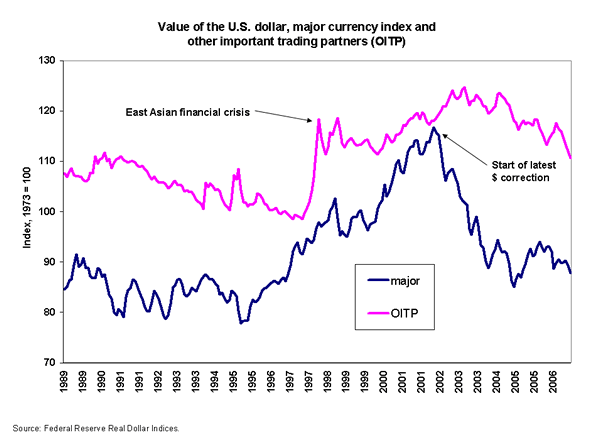See Snapshots archive.
Snapshot for December 20, 2006.
A Plunging Dollar? How Far and Relative to What?
Much has been made recently about the dollar’s recent decline against the Euro. While short-term movements in the dollar attract attention, a broader perspective on the dollar’s value is more useful for evaluating its most important implication: what it means for the U.S. trade deficit.
The Federal Reserve tracks two primary indices of the dollar’s value. The first (the major currencies index) shows that the dollar has depreciated substantially since 2002. The second (the other important trading partners index, or OITP) shows a much smaller dollar decline. As a weaker dollar aids U.S. exports and boosts the competitiveness of domestic American production, a broad-based dollar decline is necessary to close the U.S. trade deficit, now standing at over 6% of GDP. As the Figure below shows, this broad-based decline has not happened yet.

The currencies in the major index (including the euro) are freely tradable and their value is generally set in foreign exchange markets with minimal intervention by governments (the Japanese yen is an exception).1 This index has moved in a stabilizing fashion to keep the U.S. trade deficit from rising over the past five years, falling 24%.
The OITP index is comprised of 16 nations that are generally quite a bit poorer than the United States, and many of the currencies it contains (especially the Chinese yuan, which has by far the biggest weight in OITP) are actively managed by governments to keep their exports competitive in the U.S. market.2 This management is why the OITP index has seen such a smaller change than the major currency index–losing only 6% over the past five years.
The currencies in the OITP index account for roughly 55% of the current U.S. trade deficit, while the major currency index accounts for just over 30%. This makes movements in the former index even more important for correcting the U.S. trade deficit, and makes the OITP’s relative stubbornness that much more problematic for United States and global adjustment.
Notes
1. The major currency index includes: the euro, the UK pound, the Japanese yen, the Canadian and Australian dollars, the Swiss franc, and the Swedish krona.
2. The OITP index includes the currencies of Mexico, China, Korea, Taiwan, Singapore, Hong Kong, Malaysia, Brazil, Thailand, Indonesia, the Philippines, Russia, India, Saudi Arabia, Israel, Argentina, Venezuela, Chile, and Colombia.
